Kutabs are among the most popular Azeri dishes, together with plov, dolma, and of course kebabs (kebabs being a distant first: virtually the only meal you’ll ever eat in a restaurant outside of Baku). A kutab — not to be confused with kutap — is essentially a lavash filled with savory stuffing while still raw, then folded in half and pan-fried. It is often served with a sprinkling of sumac on top, a red spice which imparts a lemony note.
The most common kutab fillings are ground lamb and greens, with the occasional cheese or winter squash, but you can pretty much do whatever you want, as long as the layer of stuffing remains quite thin. In addition to the four above-mentioned classics, all of which I’m presenting here with some personal tweaks, I’ve also created two new “signature” kutabs.
My first new kutab uses foie gras and pomegranate in a nod to all the Brooklyn restaurants that feature the fattened duck liver on their menus for no apparent reason other than it’s expensive and French. Baku Palace serves kutabs and foie gras as separate dishes, so why not put them together? The second contains actual duck meat. I recently posted a duck breast kebab, and now you can use the legs (and the wings if you’d like) to make a kutab. Then you’ve got the whole bird turned into an Azeri dinner for 4!
I also offer two different ways to prepare the flatbread. In the traditional fashion, the dough is rolled paper-thin using a rolling pin. For this, you need unusually strong arms and a whole lot of patience. A small-diameter rolling pin might help, too. In these modern times, however, you can save considerable strength and time by using a pasta machine. The most common consumer models aren’t wide enough to make kutabs as wide the ones I’ve had in Azerbaijan, but I guarantee you that a smaller, triangle-shaped flatbread tastes exactly the same.
Finally, I propose a number of garnishes that I find go beautifully with each recipe. But you don’t have to follow all the recommended pairings. Mix and match! Be creative!
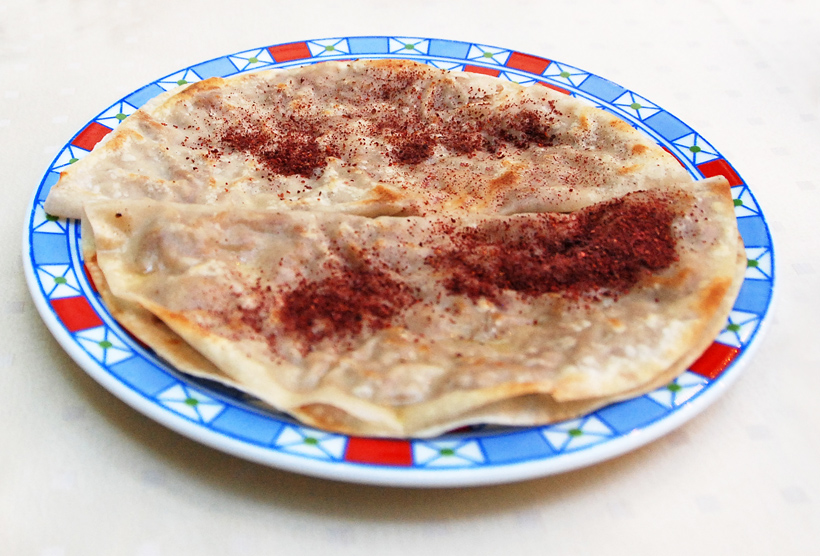
Classic lamb kutab, as served at Mugam Club in Baku
Kutab dough
Yields about 10 round kutabs, or 30 smaller kutab triangles
16 oz flour
1/2 tsp salt
8.5 oz milk
- In the bowl of an electric mixer fit with the paddle attachment, place half the flour, the salt, and the milk. Mix over medium speed until homogenous.
- Add the rest of the flour, and mix again.
- Transfer to a lightly floured surface, and knead by hand for about 3 minutes. Wrap in plastic film, and reserve for 30 minutes.
Assembling the kutabs
kutab dough
filling (see recipes below)
6 oz melted butter
garnish (see recipes below)
- If you roll the dough by hand: take about 2.2 oz of dough, and roll it into a 7.5″ diameter disc. A small-diameter rolling pin is helpful — you can repurpose any kind of wooden rod.
- If you have a pasta machine: roll the dough to the thinnest setting in a few batches. If your machine is anything like mine, cut the dough into 5″ squares. The squares are about half the size of the handmade rounds, but you’ll have far less trimming and wasted dough.
- Cover each kutab with a thin layer of filling, leaving the edges clear. Count from 1.5 oz (for flavorful greens) to 2.5 oz (for McLavash-style lamb) of filling per round kutab (and half of that for a triangle kutab). 2 oz is my rule of thumb for other stuffings — many people use no more than 1 oz, so try and see what you like best. Brush the edges with a little bit of water, fold each kutab in half, and seal. There’s no need to make the seal 100% tight.
- Heat a non-stick pan over medium heat. Brush the pan with melted butter, add a kutab, and cook until browned. Brush the pan with more melted butter, flip the kutab, and cook for the same amount of time. Remove from the pan and brush the top side with melted butter again. Add garnish and serve immediately. Suggested garnishes are listed with each filling recipe below.
Lamb filling
Yields about 4 round kutabs
3 oz peeled onion, small dice
0.5 oz peeled garlic, minced
1 oz butter
0.8 g (about 1/4 tsp) ground star anise
9 oz boneless lamb shoulder meat
5 g (about 3/4 tsp) salt
1 g (about 1/4 tsp) Urfa pepper flakes
sumac and sheep’s milk yogurt (see below)
- In a small saucepan over medium heat, sauté the onion and garlic with the butter until soft. Stir in the star anise, and cook for 1 minute. Let cool completely.
- Cube the meat, place into a bowl, and mix with the onion mixture, salt, and Urfa pepper. Process twice in a meat grinder using the small die. Refrigerate until ready for use.
- Garnish the finished kutabs with sprinkled sumac and some plain yogurt on the side.
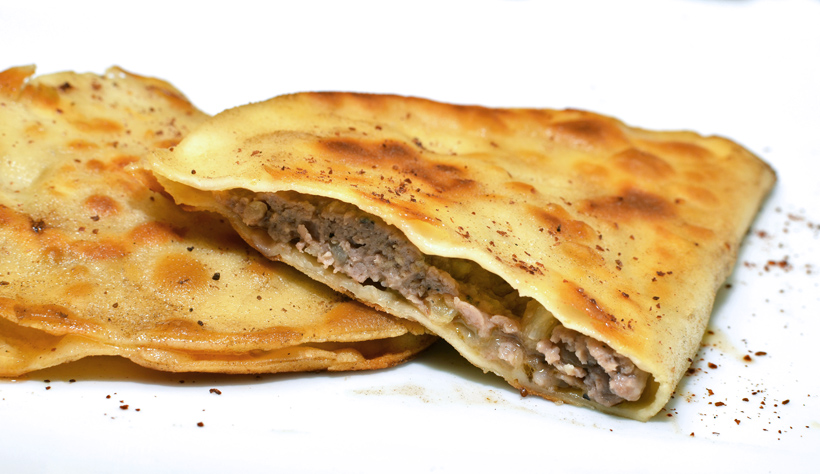
Green filling
Yields about 4 round kutabs
4 oz cleaned leek, white part only, thinly sliced
1 oz butter
salt
black pepper, ground
2.5 oz stemmed baby spinach
0.6 oz basil leaves
0.2 oz curly parsley
sumac and sheep’s milk yogurt (see below)
- In a small saucepan over medium heat, sauté the leeks in the butter. Season with salt and pepper, and cook until soft.
- Blanch the spinach and basil in salted boiling water, then shock in ice water, and drain.
- Place the leeks, spinach, basil, and curly parsley on a board, and chop finely. Reserve until ready for use.
- Garnish the finished kutabs with sprinkled sumac and some yogurt on the side.
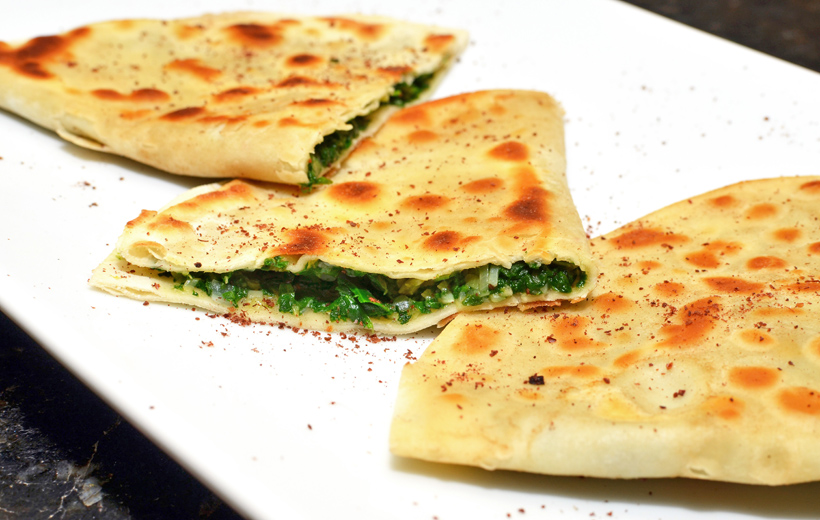
Winter squash filling
Yields about 4 round kutabs
7.5 oz orange juice
1.7 oz butter
15 oz peeled and seeded acorn squash
salt
black pepper, ground
1 1/2 tbsp mint chiffonade, plus some for garnish
- Place the orange juice in a small saucepan, and reduce to 1/3 over medium heat. Stir in the butter until melted. Reserve.
- Cut the squash into medium dice. Transfer to an oven-safe dish, season with salt and pepper, then add the orange butter. Roast in a 400 F oven for 30 minutes, stirring every 10 minutes.
- Drain the squash on paper towels and let cool.
- Transfer the squash to a bowl, add the mint, and mash with a fork. Reserve until ready for use.
- Garnish the finished kutabs with mint chiffonade.
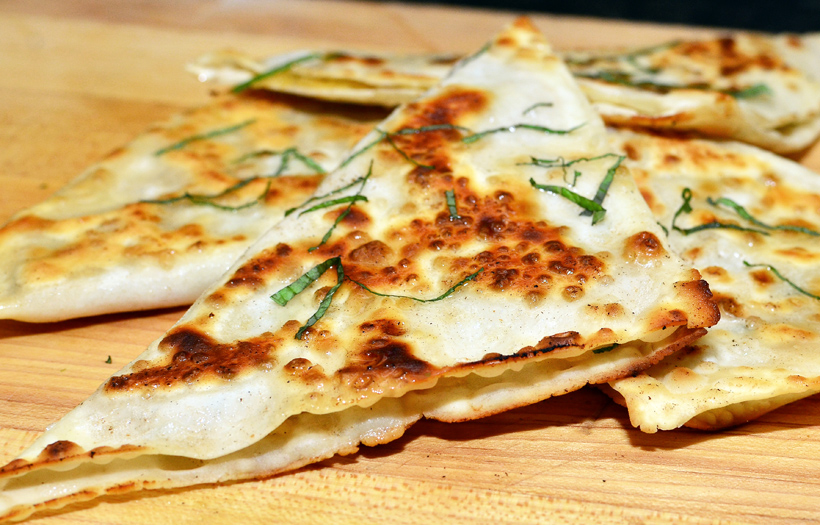
Cheese and walnut filling
Yields about 4 round kutabs
4.5 oz drained mozzarella
2.2 oz Bulgarian feta
2.2 oz kashkaval
black pepper, ground
2.5 oz ground walnuts, plus some for garnish
- In a bowl, mash the mozzarella and the feta (if you’re using a dry mozzarella, grate it instead). Grate the kashkaval, add to the other cheeses, together with the black pepper and ground walnuts, and mix well. Reserve until ready for use.
- Garnish the finished kutabs with ground walnut.
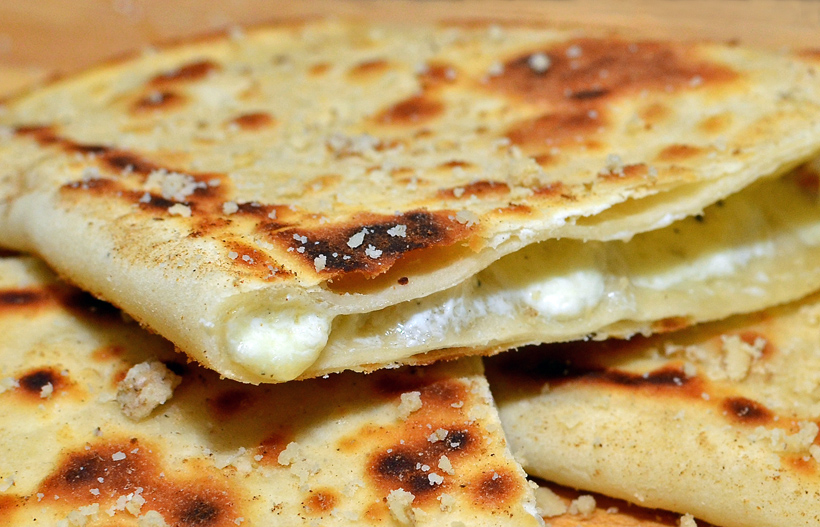
Foie gras and pomegranate filling
Yields about 4 round kutabs
6 oz duck foie gras
4.5 oz ground veal
3 oz fresh pomegranate seeds
salt
black pepper, ground
additional pomegranate seeds or narsharab (see below)
- Cut the foie gras into small dice. Transfer to a bowl with the veal and pomegranate seeds. Season with salt and pepper, and mix thoroughly with a fork. Reserve until ready for use.
- Garnish the finished kutabs with pomegranate seeds and/or drizzled narsharab.
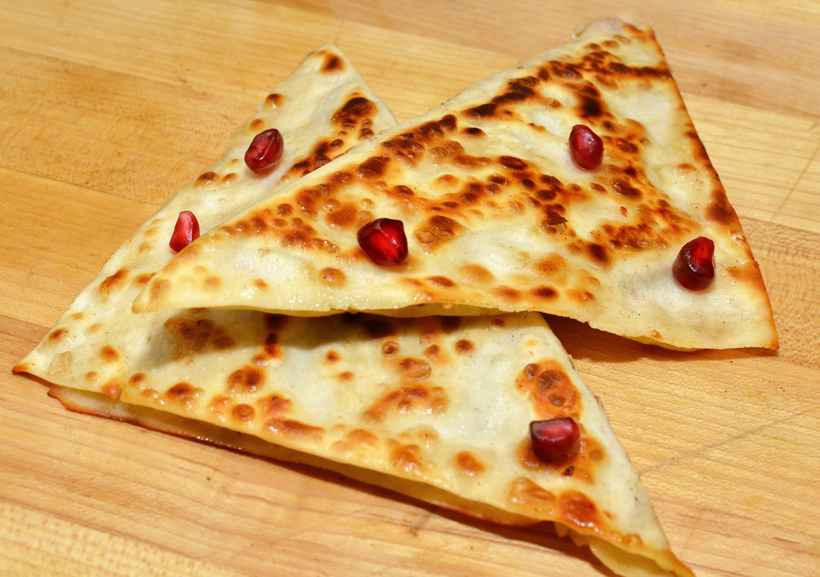
Duck filling
Yields about 4 round kutabs
legs from 1 medium-sized (about 5 lb) duck
about 10 g salt (see below)
4.8 oz thinly sliced red onion
0.8 oz duck fat
black pepper, ground
2.5 oz red wine
2.5 oz duck (or chicken) stock
sumac and narsharab (see below)
- Weight the duck legs, then measure 1% of that weight in salt. Season the legs on all sides with the salt. Place into an oven-safe dish, and roast in a 300 F oven for 1 1/2 hours. Let cool.
- In a small saucepan over medium heat, sauté the onion in duck fat. Season with salt and pepper, and cook until soft. Add the red wine and stock, then simmer until almost completely reduced. Let cool.
- Remove the skin and bones from the duck legs. Using your fingers, shred the meat into a bowl, and then stir in the onion mixture. Reserve until ready for use.
- Garnish the finished kutabs with sprinkled sumac and drizzled narsharab.
Narsharab
Yields enough for lots of kutabs
12 oz pomegranate juice
0.4 oz sugar
- Place the pomegranate juice and the sugar in a small saucepan, and reduce to about 2.5 oz over medium heat.
- Serve warm.


1 comment
These sound DELICIOUS